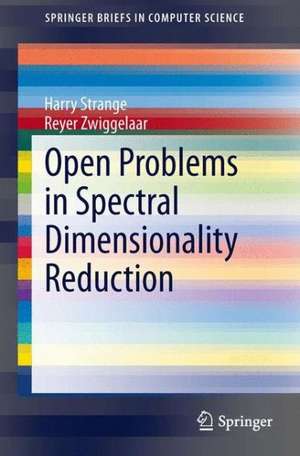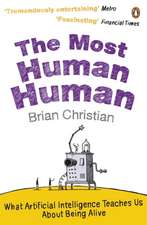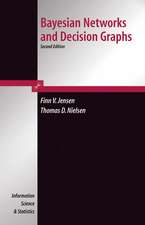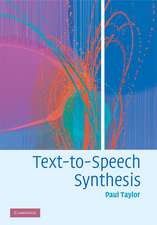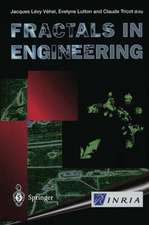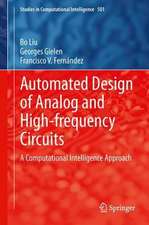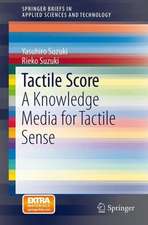Open Problems in Spectral Dimensionality Reduction: SpringerBriefs in Computer Science
Autor Harry Strange, Reyer Zwiggelaaren Limba Engleză Paperback – 21 ian 2014
Din seria SpringerBriefs in Computer Science
-
 Preț: 446.47 lei
Preț: 446.47 lei - 20%
 Preț: 296.17 lei
Preț: 296.17 lei -
 Preț: 475.83 lei
Preț: 475.83 lei - 20%
 Preț: 325.63 lei
Preț: 325.63 lei - 20%
 Preț: 166.97 lei
Preț: 166.97 lei - 20%
 Preț: 335.65 lei
Preț: 335.65 lei - 20%
 Preț: 406.90 lei
Preț: 406.90 lei - 20%
 Preț: 323.00 lei
Preț: 323.00 lei - 20%
 Preț: 323.00 lei
Preț: 323.00 lei - 20%
 Preț: 322.81 lei
Preț: 322.81 lei - 20%
 Preț: 322.17 lei
Preț: 322.17 lei - 20%
 Preț: 322.35 lei
Preț: 322.35 lei - 20%
 Preț: 321.85 lei
Preț: 321.85 lei -
 Preț: 375.45 lei
Preț: 375.45 lei - 20%
 Preț: 232.68 lei
Preț: 232.68 lei - 20%
 Preț: 324.17 lei
Preț: 324.17 lei - 20%
 Preț: 323.00 lei
Preț: 323.00 lei - 20%
 Preț: 323.34 lei
Preț: 323.34 lei - 20%
 Preț: 322.50 lei
Preț: 322.50 lei - 20%
 Preț: 324.17 lei
Preț: 324.17 lei - 20%
 Preț: 323.46 lei
Preț: 323.46 lei - 20%
 Preț: 322.17 lei
Preț: 322.17 lei - 20%
 Preț: 322.02 lei
Preț: 322.02 lei - 20%
 Preț: 323.46 lei
Preț: 323.46 lei -
 Preț: 374.08 lei
Preț: 374.08 lei -
 Preț: 408.23 lei
Preț: 408.23 lei -
 Preț: 341.50 lei
Preț: 341.50 lei - 20%
 Preț: 324.49 lei
Preț: 324.49 lei -
 Preț: 344.47 lei
Preț: 344.47 lei -
 Preț: 376.80 lei
Preț: 376.80 lei -
 Preț: 377.18 lei
Preț: 377.18 lei - 20%
 Preț: 324.17 lei
Preț: 324.17 lei - 20%
 Preț: 352.26 lei
Preț: 352.26 lei - 20%
 Preț: 321.32 lei
Preț: 321.32 lei - 20%
 Preț: 322.17 lei
Preț: 322.17 lei - 20%
 Preț: 324.17 lei
Preț: 324.17 lei - 20%
 Preț: 322.02 lei
Preț: 322.02 lei -
 Preț: 374.46 lei
Preț: 374.46 lei - 20%
 Preț: 320.21 lei
Preț: 320.21 lei - 20%
 Preț: 323.34 lei
Preț: 323.34 lei - 20%
 Preț: 324.17 lei
Preț: 324.17 lei - 20%
 Preț: 231.84 lei
Preț: 231.84 lei - 20%
 Preț: 294.95 lei
Preț: 294.95 lei - 20%
 Preț: 322.50 lei
Preț: 322.50 lei - 20%
 Preț: 321.52 lei
Preț: 321.52 lei - 20%
 Preț: 323.34 lei
Preț: 323.34 lei - 20%
 Preț: 323.00 lei
Preț: 323.00 lei - 20%
 Preț: 323.80 lei
Preț: 323.80 lei - 20%
 Preț: 323.80 lei
Preț: 323.80 lei - 20%
 Preț: 324.49 lei
Preț: 324.49 lei
Preț: 323.00 lei
Preț vechi: 403.76 lei
-20% Nou
Puncte Express: 485
Preț estimativ în valută:
61.81€ • 64.14$ • 51.67£
61.81€ • 64.14$ • 51.67£
Carte tipărită la comandă
Livrare economică 15-29 martie
Preluare comenzi: 021 569.72.76
Specificații
ISBN-13: 9783319039428
ISBN-10: 3319039423
Pagini: 104
Ilustrații: IX, 92 p. 20 illus., 15 illus. in color.
Dimensiuni: 155 x 235 x 5 mm
Greutate: 0.16 kg
Ediția:2014
Editura: Springer International Publishing
Colecția Springer
Seria SpringerBriefs in Computer Science
Locul publicării:Cham, Switzerland
ISBN-10: 3319039423
Pagini: 104
Ilustrații: IX, 92 p. 20 illus., 15 illus. in color.
Dimensiuni: 155 x 235 x 5 mm
Greutate: 0.16 kg
Ediția:2014
Editura: Springer International Publishing
Colecția Springer
Seria SpringerBriefs in Computer Science
Locul publicării:Cham, Switzerland
Public țintă
ResearchCuprins
Introduction.- Spectral Dimensionality Reduction.- Modelling the Manifold.- Intrinsic Dimensionality.- Incorporating New Points.- Large Scale Data.- Postcript.
Textul de pe ultima copertă
The last few years have seen a great increase in the amount of data available to scientists. Datasets with millions of objects and hundreds, if not thousands of measurements are now commonplace in many disciplines. However, many of the computational techniques used to analyse this data cannot cope with such large datasets. Therefore, strategies need to be employed as a pre-processing step to reduce the number of objects, or measurements, whilst retaining important information inherent to the data. Spectral dimensionality reduction is one such family of methods that has proven to be an indispensable tool in the data processing pipeline. In recent years the area has gained much attention thanks to the development of nonlinear spectral dimensionality reduction methods, often referred to as manifold learning algorithms.
Numerous algorithms and improvements have been proposed for the purpose of performing spectral dimensionality reduction, yet there is still no gold standard technique.
Those wishing to use spectral dimensionality reduction without prior knowledge of the field will immediately be confronted with questions that need answering: What parameter values to use? How many dimensions should the data be embedded into? How are new data points incorporated? What about large-scale data? For many, a search of the literature to find answers to these questions is impractical, as such, there is a need for a concise discussion into the problems themselves, how they affect spectral dimensionality reduction, and how these problems can be overcome.
This book provides a survey and reference aimed at advanced undergraduate and postgraduate students as well as researchers, scientists, and engineers in a wide range of disciplines. Dimensionality reduction has proven useful in a wide range of problem domains and so this book will be applicable to anyone with a solid grounding in statistics and computer science seeking to apply spectral dimensionality to their work.
Numerous algorithms and improvements have been proposed for the purpose of performing spectral dimensionality reduction, yet there is still no gold standard technique.
Those wishing to use spectral dimensionality reduction without prior knowledge of the field will immediately be confronted with questions that need answering: What parameter values to use? How many dimensions should the data be embedded into? How are new data points incorporated? What about large-scale data? For many, a search of the literature to find answers to these questions is impractical, as such, there is a need for a concise discussion into the problems themselves, how they affect spectral dimensionality reduction, and how these problems can be overcome.
This book provides a survey and reference aimed at advanced undergraduate and postgraduate students as well as researchers, scientists, and engineers in a wide range of disciplines. Dimensionality reduction has proven useful in a wide range of problem domains and so this book will be applicable to anyone with a solid grounding in statistics and computer science seeking to apply spectral dimensionality to their work.
Caracteristici
Provides a clear and concise overview of spectral dimensionality reduction Offers uniquely practical knowledge without requiring a background in the area Suggests interesting starting points for future research in this area Includes supplementary material: sn.pub/extras
